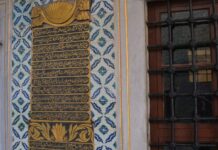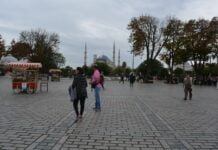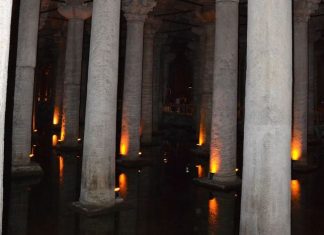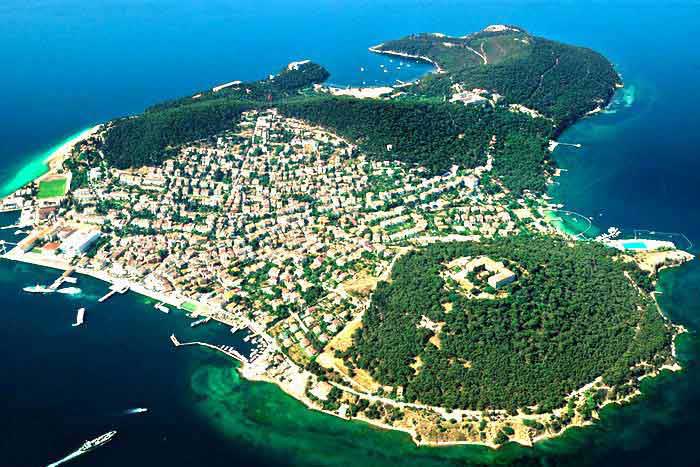The overweening blindness of Constantinople’s men arose in part from an accident of the fourth and fifth centuries. Antioch and Alexandria (that is to say, Syria and Egypt) seemed for a good while naturally to be in disharmony with each other and also with Constantinople in religious matters. But Antioch and Alexandria learned in the late fifth century and early sixth century to think more alike than ever before. Constantinople pressed on all its subjects the result of the theological balancing act of the Council of Chalcedon, with very limited success.
Antioch and Alexandria
If there had been no Constantinople for an emperor and if Antioch and Alexandria had evolved as we know they did evolve, toward a common embrace of monophysitism, the eastern provinces of the old empire would have settled down to a more or less harmonious future at a considerable doctrinal distance from Rome and the western churches. Instead, the Chalcedonism fostered at Constantinople and in the colony of similar thinking found in Jerusalem and the Judaean desert monasteries was self-satisfied and unpopular, and would stay that way. The old east, alienated in faith from its own capital, lay ripe for Islam’s taking, and left Constantinople in a state of lonely splendor, a milieu that came to be called Byzantine. It was still orthodox Chalcedonian, but quite irrelevant and isolated on history’s stage, however long it survived.
The development of Justinian’s passion for orthodoxy will follow us through our story of the next decades. With too little schooling, he became an aficionado of theology and theologians. The settling of the Acacian schism marked his uncle Justin’s rise, along with the abandonment in Constantinople of Zeno’s Henotikon of thirty-five years earlier, the document that had almost held together a world of conflicting opinions. Justinian had little real idea what forces he was playing with. (Among other things, he never traveled south and east from his capital to see any of the heartlands of his empire or to confront its religious traditions face to face.) His backhanded attempts to stifle fashionable Arianism along the northern frontier and in Italy aggravated his falling-out with Theoderic and Theoderic’s successors—a situation that probably pleased Justinian perfectly well, though it set Italy on a course that ended in the ruinous wars of the 530s through the 550 s balkan tours 2022.
And meanwhile, grave men were making a future for Christian theology that did not take Constantinople seriously. Severus was patriarch of Antioch in Syria until he was expelled in the Chalcedonian upthrust under Justin. In exile, he became the hero of this generation of one-nature theologians, and most accounts of the period follow the rise of his movement to respectability and power. But there were nastier undercurrents. Michael the Syrian, a much later orthodox chronicler, offers a letter to the emperor, ostensibly from a Jewish community, circulating in the early sixth century but purporting to have been written just after Chalcedon half a century earlier:
To the merciful Emperor Marcian: from the people of the Hebrews.
For a long time we have been regarded as though our fathers had crucified a God and not a man. Since the synod of Chalcedon has assembled and demonstrated that he who was crucified was a man and not a God we request that we should be pardoned this fault and that our synagogues should be returned to us.
The fool who accepted that text as authentic would also believe that the Chalcedonians were nothing but Jews, but there were such fools aplenty by that time.
Disproportionate influence
Meanwhile, heroic examples of saintliness had a disproportionate influence on the public mind. Saints are hard to control. Early in the fifth century, a man named Simeon sat on a six-foot-square platform, atop a sixty-foot pillar high in the Syrian countryside, and remained there for, we are told, thirty-six years, preaching to the crowds that gathered below twice a day. The emperor Zeno shrewdly provided funds to build a great church around the site of Simeon’s pillar—the better to benefit from his famous holiness when his tart tongue was no long able to criticize em¬perors.20 A more practically opportunistic man, named Daniel, found the suburbs of Constantinople a better location for a pillar and established a reputation so strong that the patriarch of the city came to him to ordain him to the priesthood—patriarch on the ground, Daniel in the air. From his aerie, Daniel cured the sick, foretold disasters and rescues, and even chased demons away from an old temple some distance from his pillar.21 A contemporary wrote this poem about him:
Midway between earth and sky there stands a man With no fear for the gales that swirl around him At the palace of Hormisdas.
His name is Daniel; he competes with great Simeon, preaching the son of the mother who did not know man.
Hunger is the ambrosia he feeds on; thirst is his bloodless drink;
He plants his feet on a twice-strong column.








